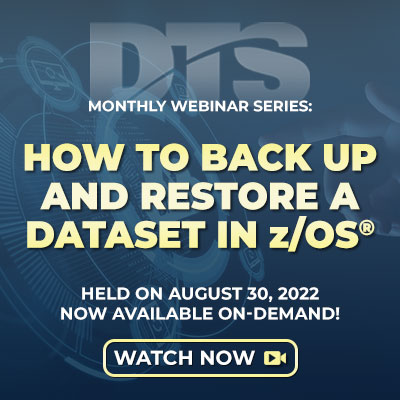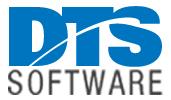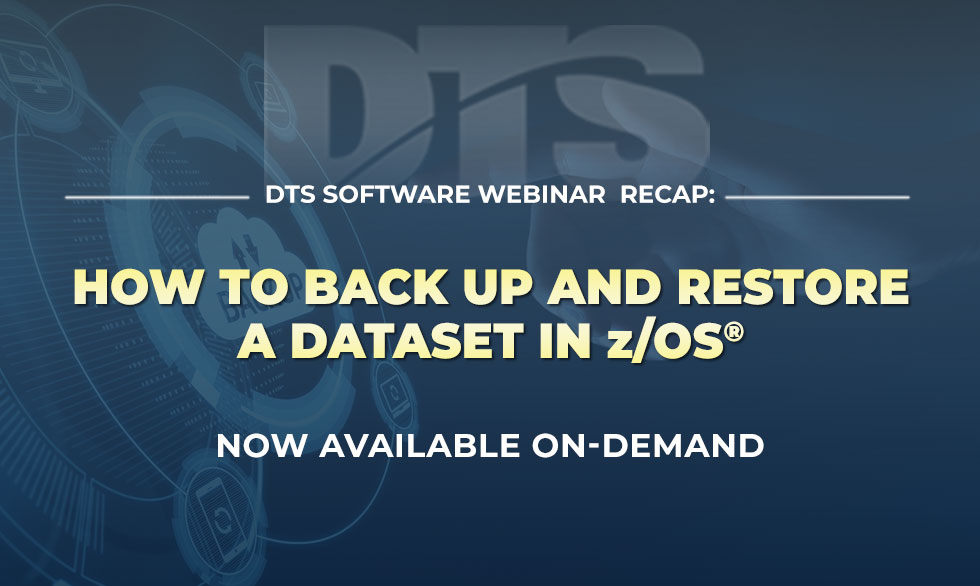The handling of datasets as they move up and down the hierarchy is a key focus for any data center manager. When a dataset becomes damaged or inaccessible, being able to recreate it from a backup is paramount.
While data center-wide backups are usually performed by the storage management department, restores are often the responsibility of the user. There are many complexities to creating and maintaining backup systems but restoring is often more straightforward. Understanding the programs, mechanisms, and commands involved with creating and especially locating backups and performing restores is an important skill for the z/OS user.
Taking backups isn’t something to be overlooked or done on occasion. The question is who takes them, why are they taken and where do they fit in the storage management scheme? In a recent webinar, DTS Software CTO Steve Pryor discussed the major backup systems (DFSMShsm, FDR, CA-Disk), their functions and operation, and how to restore backed-up datasets.
Basic but Critical Functions
Backup and restore are basic functions, but they are also critical functions, especially for large data centers when a dataset gets damaged, deleted by accident, or there is a hardware failure. This could also apply to entire volumes or storage groups in a disaster recovery situation.
Data Availability Management vs Space Availability Management
Storage management in z/OS is usually divided into two camps: data availability management and space availability management. What is the difference and what are their goals?
The goals of data availability management are to ensure the datasets that are supposed to be backed up are backed up, that they are backed up as frequently as needed, and that they are available to be restored when needed. The lifecycle of a dataset as it pertains to data availability management is short and often several versions are vaulted.
The purpose of space availability management is to ensure sufficient free space is available to allow the production workload to run. This involves managing the dataset’s movement through the hierarchy from primary disk to compressed disk, tape, or even to the cloud.
With space availability management, datasets are deleted off the disk when a backup is completed (usually referred to as migrates or archives). The dataset’s lifecycle is much longer, generally only one or two copies exist, and a recycle function must be performed as the dataset ages on the archive media.
The Most Frequently Used Backup Types in z/OS
Backup types and the programs most widely used to perform backups in z/OS were the next points of discussion in the webinar. Backups are generally taken by data center management, storage administrator, the operators, or by automatic function.
Full volume backups occur when backing up all the datasets in a particular volume. Dataset backups occur when individual datasets are backed up. And one of the most common backup types is an incremental backup, which is typically done on a volume basis. Incremental backups simply mean that only the datasets that have changed are backed up, and these are usually done daily. Other less-frequently used backup types were also mentioned.
From here, Pryor focused on HSM and FDR, two of the most widely used backup and restore utilities. He then took a deep dive, giving numerous examples and how-to explanations, and offered a “cheat sheet” of terminology with HSM versus FDR, which was included in the presentation slide deck.
You Have the Backup, Now How Do You Restore it?
The remainder of the webinar focused on restoring the data when you need to, whether that be from disk, tape, or the cloud. Pryor once again presented a number of how-to examples and discussed the different approaches depending on the utility you are using.
Backup and Restore Reference Resources
If you need to find more reference material on backing up and restoring in z/OS, Pryor once again provided information on key reference resources available to those who need it. Steve is also available via email to answer questions about this topic. He can be reached at steve@dtssoftware.com.
 Learn More in Our Webinar Available On-Demand
Learn More in Our Webinar Available On-Demand
As with each of our monthly webinars, “How to Back Up and Restore a Dataset in z/OS” is a 60-minute informative and educational look at an important topic in the mainframe space. It includes numerous examples, how-to guides, and references on where to find more information should you need it.
If you weren’t able to attend or would like to review the material presented, you can view it on-demand and download a copy of the slide deck by using this link. Be sure to join us each month for our complimentary webinar series. Go to www.dtssoftware.com/webinars for more information.


